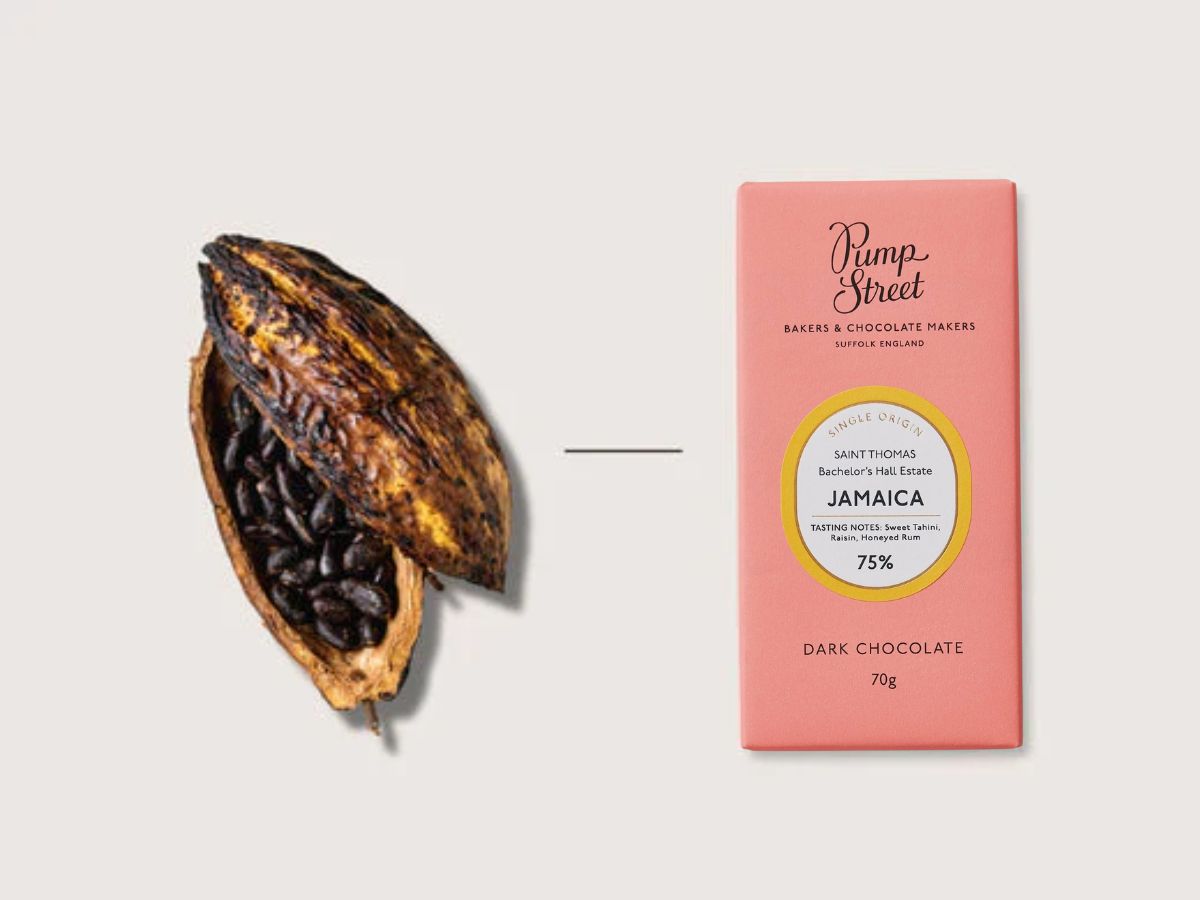FREE DELIVERY ON CHOCOLATE ORDERS OVER £35
FREE DELIVERY ON CHOCOLATE ORDERS OVER £35
SHOP CHOCOLATE
How Bean to Bar Chocolate Is Made
by Joanna Brennan November 06, 2024 6 min read

From raw beans to refined bars, this is the process behind our chocolate.
As a term, ‘bean to bar’ marks the full circle a cocoa bean travels — from its earthly beginnings on a farm to its transformation into a delicious bar of chocolate.
We know chocolate lovers can appreciate the craft as much as we do so we're opening up about our process, inviting you inside our small factory in the vicinity of Orford, Suffolk, to uncover the intricate steps of making our chocolate from bean to bar.
Contents - How Bean to Bar Chocolate is Made:
- Sourcing the Beans
- Bean Selection and Sorting
- The Roasting Process
- Breaking and Winnowing
- Grinding and Conching
- Maturing the Chocolate
- Tempering and Moulding
- Packaging the Bars
- Quick Summary

Sourcing the Beans
Let’s start at the very heart of the matter — the beans themselves.
The cocoa beans we source come from a careful selection of farms around the world. The image above shows a cocoa pod from La Pareja farm in Peru where we get the beans for the Peru 72% bar. Notice the pod's thick shell. This is nature’s way of protecting the precious beans inside which are also encased by 'mucilage', a white, sticky substance that envelops each bean.
The chocolate making process begins when the pods are picked and harvested in the cocoa orchards and then fermented and dried, in the case of our beans, usually directly at the farm. The fermentation process is an intricate balance of time and temperature and it's different for every batch of beans we receive. Our farmers are experts at knowing just when the beans are ready to be dried, usually under the open sun. Through fermentation, they'll lose of their astringency and gain a more rounded, deep cocoa profile.
It's a simple process, but there's an art to getting it just right and it sets the stage for everything that comes next in our Suffolk factory. By the time these beans arrive at our doorstep, they've already been through a journey of care and transformation. That's where our part in the bean to bar process begins.

Bean Selection and Sorting
The beans arrive at our Suffolk chocolate factory cradled in huge burlap sacks, each stamped with its origin as a passport of its travels.
Upon arrival, we open up the sacks and spread the beans out to begin the sorting stage. It's a hands-on task where our seasoned sorters sift through the beans, looking for any that don't meet our high standards. This might be because of things like size, colour, breakages or any kind of imperfections that can affect the taste and flavour of our chocolate. We choose to do this manually because precision matters. We want to make sure only the very best beans make it into our chocolate.
Only the beans that pass our rigorous selection process then go on to the next step - roasting.

The Roasting Process
The scent of roasted cocoa envelops you the moment you step into our Suffolk chocolate factory. This is because roasting is where the magic of our impact on flavour development really begins.
Through carefully controlled temperatures and timing, roasting coaxes out the deeper and more chocolate-y notes and help us to define each batch's unique character.
We spread the beans out on spacious metal trays designed with lots of tiny holes that allow for even heat distribution. We need to make sure that each bean can be roasted and toasted to perfection.
We listen for the 'crack'—a tell-tale sign that the husk is separate from the bean. We always roast our beans whole - a step which adds time and expense, but ensures that the precious nibs in side our beans are roasted gently and evenly before being broken apart.

Breaking and Winnowing
Once the roasted beans are cracked open, they reveal the tender nibs. We then move on to winnowing — perhaps a less familiar term outside the bakers and chocolate makers vocabulary, but no less important.
Winnowing is the meticulous separation of the precious cocoa nibs (the part of the bean that's ground to make chocolate) from their shells, or husks. In the image above you see a bucket of our broken up cocoa beans, including the husks and nibs. This is the starting point for winnowing.
With the help of some of our specialised equipment, the crisp, lighter shells are whisked away by a stream of air, leaving behind only the pure, rich nibs for collection.
This winnowing stage is essentially separating the wheat from the chaff, to make the baking analogy, and ensuring that only the best of the bean makes it to the next step of becoming Pump Street Chocolate.

Grinding and Conching
After winnowing, the nibs undergo a transformation from their raw, granular state into a rough cocoa paste.
The first step in this metamorphosis is grinding during which the nibs, sugar and cocoa butter are ground down from a rough mixture, gradually to a smooth paste.
Next comes the conching process, sometimes in the same machine, but which has a very different purpose; less about the physical transformation and more about the addition of air, and removal of volatile acids, to develop and refine the final flavour of the chocolate.
Our conching process is not rushed; it normally can take us three to four days.

Maturing the Chocolate
This image above shows chocolate has just been emptied from our conching machines and is cooled before being wrapped and aged.
Just as a fine wine deepens in character as it rests, so too does our chocolate. We mature our chocolate for 30 days, allowing the flavours to meld together to create the best tasting bars possible.The bars are kept in a controlled environment where temperature and humidity are kept in perfect balance to promote this evolution.
Tempering and Moulding
After our chocolate has matured, the next stage is tempering.
Once tempered, the chocolate is ready to take its final form. We pour the silky mixture into moulds. The chocolate then settles into its shape. Gentle indentations.

Packaging the Bars
As the chocolate sets and cools, we turn our attention to wrapping the bars.
You can find out much more about the details of our chocolate bar packaging in this post.
Our transparent labelling on the packaging is a testament to our commitment to traceability and quality. Each bar we make carries a label on the front, declaring the country of origin, and the name of the farm where the cocoa beans were grown. For bars without inclusions we include the region also.
Flipping to the back, you will find the crop year of the beans as well as the batch code which traces every sack of beans through to the finished bar.
In the folds of the wrappers, you might find hidden stories. Illustrations to catch your eye, small homages to Orford the home of Pump Street's bean to bar chocolate.
With the final seal, the bars are ready to be boxed and shipped from Suffolk to chocolate lovers like you. Ready to be slipped into a bag, shared among friends, or given as a token to someone special.

Summary: Journey of a Cocoa Bean to Chocolate Bary
cocoa pod → the protective shell where cocoa beans begin their journey.
harvest → the process of collecting ripe cocoa pods from the trees.
ferment → where harvested beans are fermented to develop their flavours.
dry → beans are then dried, reducing moisture to prepare them for roasting.
bean → the dried beans are selected, sorted and cleaned.
roast → roasting further develops the beans' flavour and aroma.
crack → the roasted beans are cracked to separate the nibs from the shells.
winnow → the shells are removed, and the nibs are collected for grinding.
grind → the nibs are ground into a rough paste.
conch → the chocolate is further mixed and refined.
temper → the chocolate is cooled and heated to stabilise it for a shiny finish and snap.
mould → the tempered chocolate is poured into moulds to set into bars.
wrap → the set bars are wrapped and packaged.
bar → the final product, ready to be enjoyed by you.
Experience the bean-to-bar journey for yourself
We invite all chocolate lovers to join us for a hands-on chocolate making experience in Suffolk where you’ll taste, create, and learn about bean to bar chocolate alongside our experts. Find out more: Craft Chocolate Workshop

Subscribe
Sign up to get the latest on sales, new releases and more …


